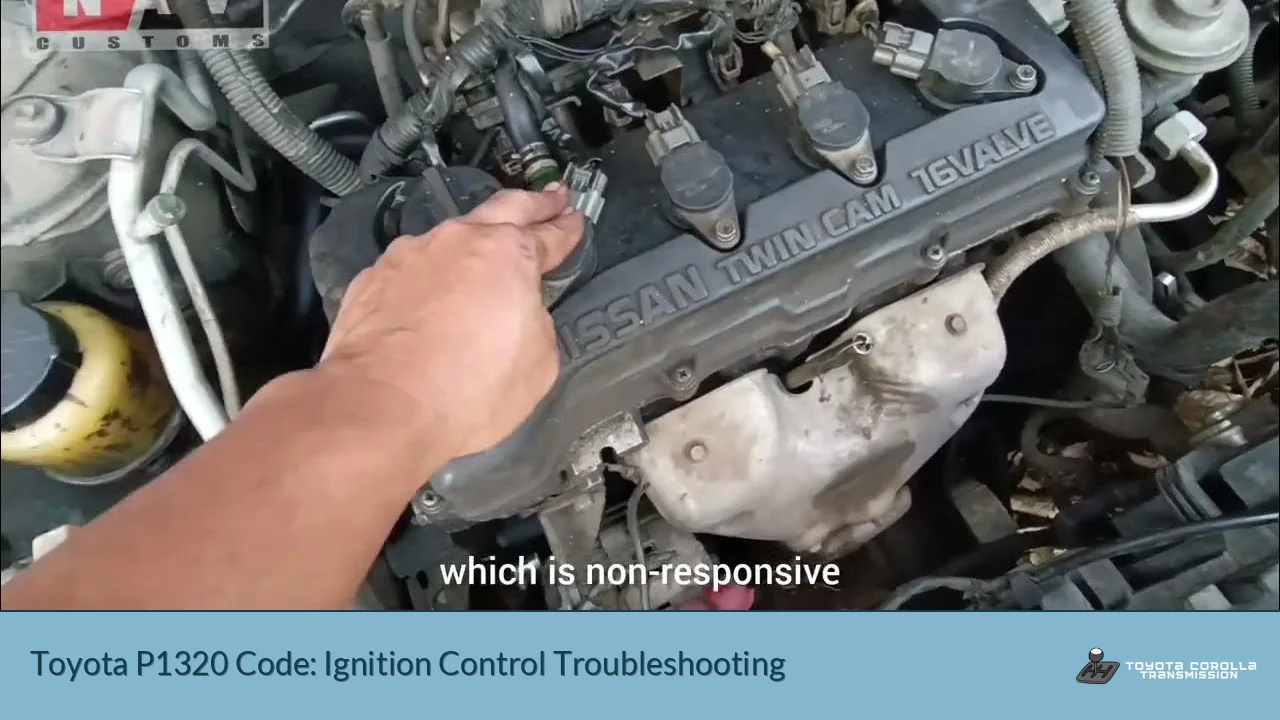When your Toyota’s dashboard lights up with the P1320 error code, it’s signaling a potential issue with the ignition control system, specifically related to cylinder No. 5. This diagnostic trouble code (DTC) indicates a circuit malfunction that could affect your vehicle’s performance and fuel efficiency. Understanding the intricacies of this error code is crucial for proper diagnosis and timely repair.
| Aspect | Description | Potential Impact |
|---|---|---|
| Code Definition | Ignition control – cylinder No. 5 – circuit malfunction | Affects engine performance |
| Primary Causes | Wiring issues, faulty ignition coil/module, ECM problems | Can lead to misfires and reduced power |
| Severity | Moderate to High | May cause drivability issues if left unaddressed |
Understanding the P1320 Code
The P1320 code specifically points to a problem with the ignition control circuit for cylinder No. 5 in Toyota vehicles. This issue can manifest in various ways, from subtle performance changes to more noticeable drivability problems.
Symptoms of P1320
When your Toyota triggers the P1320 code, you might experience:
- Engine misfires, especially under load
- Reduced fuel economy
- Rough idling or stalling
- Decreased acceleration
- Illuminated Check Engine Light
These symptoms can vary in severity, but they all indicate that your engine’s ignition system isn’t functioning optimally.
Common Causes of P1320
Several factors can contribute to the P1320 code appearing:
- Faulty Ignition Coil: The ignition coil for cylinder No. 5 may be failing or have failed completely.
- Damaged Wiring: Frayed or corroded wires in the ignition circuit can disrupt the electrical signal.
- Defective Spark Plug: A worn or damaged spark plug can cause ignition issues.
- ECM Malfunction: In rare cases, the Engine Control Module itself may be the culprit.
- Sensor Issues: Faulty crankshaft or camshaft position sensors can lead to timing problems.
Diagnosing P1320 in Toyota Vehicles
Proper diagnosis is crucial for effectively addressing the P1320 code. Here’s a step-by-step approach:
Step 1: Initial Scan and Data Analysis
Begin by using an OBD-II scanner to confirm the P1320 code and check for any additional codes that might provide more context. Pay close attention to live data streams related to ignition timing and misfire counts.
Step 2: Visual Inspection
Perform a thorough visual inspection of the ignition system components:
- Check for visible damage to wiring harnesses
- Inspect the ignition coil for signs of wear or damage
- Examine the spark plug and its connection
Step 3: Component Testing
- Test the Ignition Coil: Use an ohmmeter to check the primary and secondary resistance of the ignition coil for cylinder No. 5.
- Spark Plug Inspection: Remove and inspect the spark plug for wear, fouling, or damage.
- Wiring Continuity Test: Check the continuity of the wiring between the ECM and the ignition coil.
Step 4: Advanced Diagnostics
If initial tests are inconclusive:
- Use an oscilloscope to analyze the ignition coil’s primary and secondary voltage patterns
- Perform a cylinder compression test to rule out mechanical issues
- Consider swapping the ignition coil with a known good one from another cylinder to see if the problem moves
Resolving the P1320 Code
Once you’ve identified the root cause, here are the typical steps to resolve the P1320 code:
- Replace Faulty Components: If diagnostics reveal a faulty ignition coil, spark plug, or wiring, replace these components with high-quality OEM or equivalent parts.
- Repair Wiring Issues: Carefully repair any damaged wiring, ensuring proper insulation and connection.
- Update ECM Software: In some cases, an ECM software update may be necessary to resolve timing or control issues.
- Clear the Code and Retest: After repairs, clear the code using an OBD-II scanner and test drive the vehicle to ensure the problem is resolved.
Remember, proper diagnosis is key to avoiding unnecessary parts replacement and ensuring a successful repair.
Preventing Future P1320 Codes
To minimize the risk of encountering the P1320 code again:
- Follow Toyota’s recommended maintenance schedule
- Use high-quality replacement parts
- Address any engine performance issues promptly
- Keep the battery and electrical system in good condition
The Importance of Timely Repairs
Ignoring the P1320 code can lead to more severe engine problems over time. A malfunctioning ignition system can cause unburned fuel to enter the exhaust system, potentially damaging the catalytic converter. Additionally, prolonged misfires can lead to engine damage and decreased fuel efficiency.
FAQs
What does the P1320 code mean for Toyota vehicles?
The P1320 code indicates a malfunction in the ignition control circuit for cylinder No. 5. It typically suggests issues with the ignition coil, wiring, or related components.
Can I drive my Toyota with a P1320 code?
While you may be able to drive short distances, it’s not recommended. The code can cause misfires and reduced performance, potentially leading to more serious engine damage.
How much does it cost to fix a P1320 code?
Repair costs can vary widely depending on the cause. Simple fixes like replacing a spark plug may cost under $100, while more complex issues involving the ECM could exceed $500.
Is P1320 a serious code?
P1320 is considered moderately serious. While not immediately catastrophic, it can lead to significant engine problems if left unaddressed for an extended period.
How long does it take to fix a P1320 code?
Repair time can range from 1-3 hours for simple component replacements to several hours for more complex diagnostic and repair procedures.

